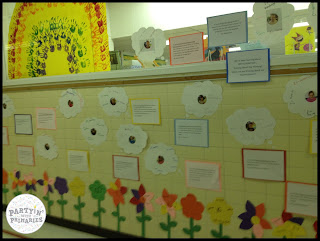How many of you have heard of Tanny MacGregor? She is absolutely incredible... She taught for over 25 years in the Cincinnati area, and and is now a TOSA presenting at workshops around the country! One of my most treasured teaching tools is her book, Comprehension Connections. It is exactly what it sounds... a book of tools and ideas, full of ways to help students make connections to comprehension strategies.
When I first read this book, and it talked about teaching firsties metacognition... I thought it was absolutely crazy. I hardly even knew what metacognition was... (It is "thinking about your thinking," for those of you that are wondering.) Anyways despite my reluctance, I decided to jump in and give it a try!
We started by making a "reading salad," comprised of our thinking and the text. As we took a picture walk through the book, we worked together.
I pointed to the title of the book and read aloud "David Gets in Trouble by David Shannon." The students had to work together to decide whether we should add a text card or thinking card. They chose "text."
Then I pointed to my head and said, " I'm thinking that this book is going to be about a boy named David that is constantly getting in trouble." The kids nodded their heads in agreement and we add a thinking card.
This process is continued as we completed our picture walk; I also used it to pre-teach vocabulary and have any quick discussions that I had in mind before they began to read independently. I allowed each child to make a "reading salad" while they read. I proceed to listen to each of the kids read and checked for comprehension, just like I do any other day during guided reading.
Next, I gave the kids thinking stems (prompts) to help them generate sentences about metacognition during their reading.
- I'm thinking...
- I'm noticing....
- I'm wondering...
- I'm seeing...
- I'm feeling...
Kids were given sticky notes, and asked to generate at least TWO thinking stems while they were reading. This was a more concrete way for them to demonstrate their metacognition while they read! Again, I modeling this strategy for them...
I was SHOCKED to see how quickly they caught on, and were able to apply their thinking to the text through writing! How often do I sell them short?!? They're like little sponges!
We then used the sticky notes to generate complete sentences on a graphic organizer. I did this mainly because it was what they would be seeing in the future at their Daily 5 stations as a form of accountability. (Next week they will be completing these graphic organizers at Listening Station, Read to Self, Read to Someone and Computer Station).
At the end of their reading time, I did a quick -reteaching of the word metacognition and show how the text + thinking = real reading, using the Tanny MacGregor chart!.
As a whole class extension beyond the guided reading table, we each made our own "thought bubbles" that helped the students to verbalize their thinking about the books they were reading.
I realize the picture is small but here is one example....
"In the book David Goes to School by David Shannon, I am thinking that David is in trouble. I am thinking that he needs to keep his hands to himself. I'm noticing that he is mad." -First Grade Student
Not too bad for first grade, huh?!? The kids were especially excited that we had the laptop cart that day, and once I conferenced with them to approve their sentences, they were able to type and print them out! My kids always love anything that allows them to utilize technology... and it is great typing practice for them as well! This extension project became a great hallway display for the next few weeks!
Don't forget to check out all the other teachers that are sharing their own Smashing Strategies for Guided Reading!




































